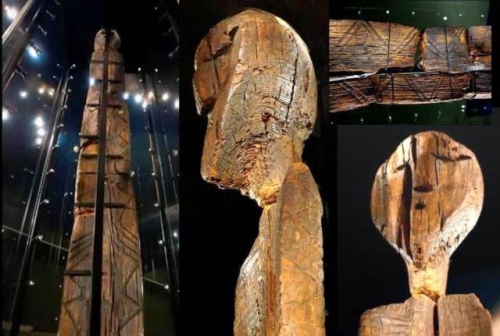mardi, 27 octobre 2015
Russia’s Urals region might hold the key to Europe’s ancient origins

Russia’s Urals region might hold the key to Europe’s ancient origins
In August 2015, the Shigir Idol was recognized as the world’s oldest known wooden sculpture. Prominent dendrochronologists and archeologists established that the statue is 11,000 years old, dating to the start of the Holocene period at the end of the last Ice Age and beginning of the present era.
The scientific community will probably have to revise the prevailing opinion that almost everything, starting from crop farming to philosophical perceptions of the world, was brought to Europe by ancient Middle Eastern farmers.
Mikhail Zhilin, a leading researcher at the Russian Academy of Science’s Institute of Archeology, is convinced that hunter-gatherers who lived in the Urals and Siberian forests 11,000 years ago exhibited a high level of development. “They lived in harmony with the environment and knew far more about it than modern people can imagine,” Zhilin told RBTH.
The mystery of the idol: a seventh drawing
In 2014 Professor Thomas Terberger, head of research at the Department of Cultural Heritage of Lower Saxony (Hannover), proposed an independent analysis of the Shigir Idol. He wanted to establish the age of the sculpture using the most advanced equipment available, and tests subsequently showed that the idol was older than previously thought, in fact dating to 11,000 years ago.
Dendrochronologists at the German Archeological Institute in Berlin established that the idol was made out of freshly-cut Siberian larch. The tree was at least 157 years old when the ancient craftsmen began to work on it.
Prof. Terberger believes the Shigir Idol is one of the most outstanding Eurasian cultural masterpieces of the Stone Age. “Based on our studies, one can boldly assert that the development of Eurasian culture was driven not only from the Middle East but from other equally developed centers, in particular, from the Urals,” Terberger said.
Furthermore, scientists recently discovered a seventh mysterious drawing on the idol’s back side, which can be seen only with the help of a microscope. Previously, only six drawings were known. There are markings carved on the idol that depict a series of figures, with a total of eight characters. Their meaning remains a mystery, as well as many other of the idol’s secrets – what it was made for, and with what tools.
How the idol was discovered and studied
The Big Shigir Idol was discovered in 1890 in a peat bog halfway between Yekaterinburg and Nizhny Tagil. At that time, the area was known for its gold mine. During excavations many ancient artifacts of the Shigir peat bog were lost but some were preserved, such as Stone Age bone arrowheads.
The idol was retrieved from the bog piece by piece, and when they were assembled it turned out they form a sculpture 5.3 meters tall, covered with mysterious carvings. Later, the lower part of that archeological wonder (about 193 cm long) was lost. The gold mine’s owner, Count Alexey Stenbok-Fermor, handed over the idol to the Urals Natural Sciences Society, today known as the Sverdlovsk Region History Museum.
Russian scientists first began to study the idol in 1997, and with the help of radiocarbon analysis they established that the idol was at least 9,500 years old. That announcement caused quite a stir, and skeptics suggested somebody had taken a larch lying in a peat bog for 3,000 or 5,000 years and made an idol out of it. Still, scientists knew that the idol would reveal more secrets.
“We were convinced that it was originally made out of a freshly-cut tree because we know how quickly wood taken out of a peat bog becomes dry and deformed, leaving it practically useless for making a sculpture,” said Svetlana Savchenko, a research associate at the Sverdlovsk Region History Museum.
Read more:
Ancient petroglyphs in the Russian North covered with a glass dome>>>
Russia’s 12 oldest ancient monuments>>>
00:05 Publié dans archéologie | Lien permanent | Commentaires (0) | Tags : monts ourals, archéologie, russie, racines européennes |  |
|  del.icio.us |
del.icio.us |  |
|  Digg |
Digg | ![]() Facebook
Facebook



Les commentaires sont fermés.